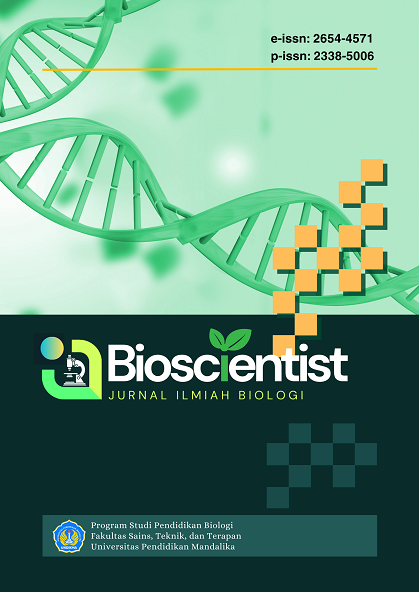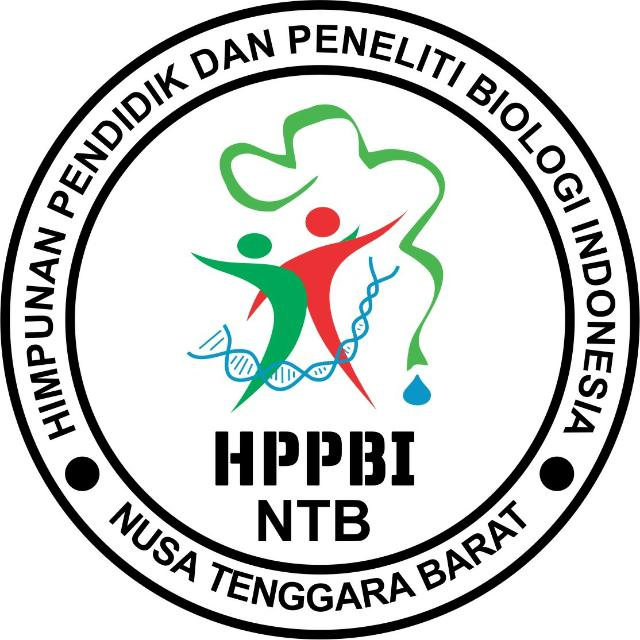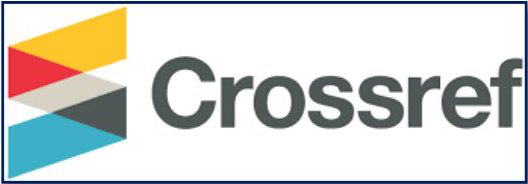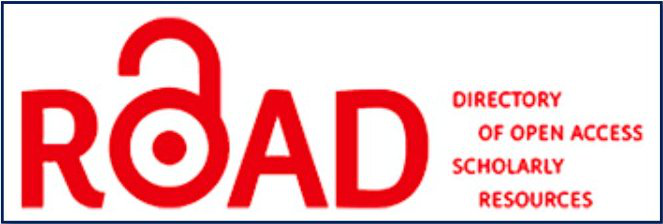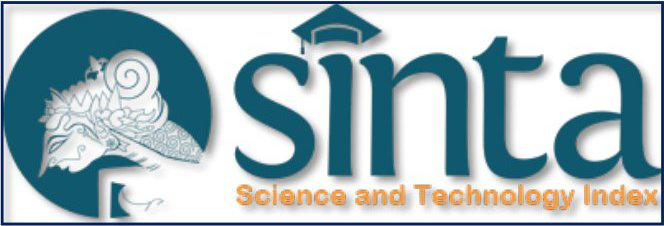Isolation and Morphological Characterization of Fungal Isolates from Leachate of Namo Bintang Landfill, North Sumatra
DOI:
https://doi.org/10.33394/bioscientist.v13i4.18277Keywords:
Bioremediation, fungal diversity, isolation, landfill leachate, morphological characterizationAbstract
This study aims to isolate and characterize the morphological characteristics of fungal colonies obtained from leachate water at a landfill site. To obtain fungi from leachate water, the following steps were taken: Fungi were isolated using the pour plate method with Potato Dextrose Agar (PDA) medium; morphological characterization of fungi was performed macroscopically and microscopically. Macroscopically, by observing the shape, edges, texture, and color of the fungal colonies, and microscopically, by observing the shape of the hyphae and the presence of asexual spores. The results showed that seventeen fungal isolates were successfully isolated from the leachate of the Namo Bintang landfill with different morphologies. The macroscopic characteristics of the fungal colonies showed that 15 fungal isolates had round colonies, and the other two isolates (NKD 07 and NKT 14) had irregular colonies. The edges of the fungal colonies varied, ranging from flat, wavy, to serrated. The color of the fungal colonies was predominantly gray and green. The texture of the fungal colonies varied from powdery, hairy, smooth, to cotton-like. Microscopic characteristics of the fungi show that most fungal isolates have septate hyphae and varied conidia shapes, such as round, oval, crescent, and tubular. These findings indicate that the leachate from the Namo Bintang landfill contains diverse fungi with different colony morphological characteristics, making it possible to develop them as biological agents.
References
Abdel-Shafy, H. I., Ibrahim, A. M., Al-Sulaiman, A. M., & Okasha, R. A. (2024). Landfill leachate: Sources, nature, organic composition, and treatment: An environmental overview. Ain Shams Engineering Journal, 15(1), 102293.
Ban, Y., Tang, M., Chen, H., Xu, Z., Zhang, H., & Yang, Y. (2012). The response of dark septate endophytes (DSE) to heavy metals in pure culture. PLoS one, 7(10), e47968. https://doi.org/10.1371/journal.pone.0047968
Bazzicalupo, A. L., Ruytinx, J., Ke, Y. H., Coninx, L., Colpaert, J. V., Nguyen, N. H., ... & Branco, S. (2020). Fungal heavy metal adaptation through single nucleotide polymorphisms and copy‐number variation. Molecular Ecology, 29(21), 4157-4169. https://doi.org/10.1111/mec.15618
Calhim, S., Halme, P., Petersen, J. H., Læssøe, T., Bässler, C., & Heilmann-Clausen, J. (2018). Fungal spore diversity reflects substrate-specific deposition challenges. Scientific Reports, 8(1), 5356. https://doi.org/10.1038/s41598-018-23292-8
Campillo-Cora, C., Rodríguez-Seijo, A., Pérez-Rodríguez, P., Fernández-Calviño, D., & Santás-Miguel, V. (2025). Effect of heavy metal pollution on soil microorganisms: Influence of soil physicochemical properties. A systematic review. European Journal of Soil Biology, 124, 103706. https://doi.org/10.1016/j.ejsobi.2024.103706
Colin, V. L., Baigorí, M. D., & Pera, L. M. (2013). Tailoring fungal morphology of Aspergillus niger MYA 135 by altering the hyphal morphology and the conidia adhesion capacity: biotechnological applications. Amb Express, 3(1), 27. https://doi.org/10.1186/2191-0855-3-27
Daniel, A. N., Ekeleme, I. K., Onuigbo, C. M., Ikpeazu, V. O., & Obiekezie, S. O. (2021). Review on effect of dumpsite leachate to the environmental and public health implication. GSC Advanced Research and Reviews, 7(2), 051-060. https://doi.org/10.30574/gscarr.2021.7.2.0097
Fomina, M., Gromozova, O., & Gadd, G. M. (2024). Morphological responses of filamentous fungi to stressful environmental conditions. Advances in applied microbiology, 129, 115–169. https://doi.org/10.1016/bs.aambs.2024.07.001
Gadd, G. M., Ramsay, L., Crawford, J. W., & Ritz, K. (2001). Nutritional influence on fungal colony growth and biomass distribution in response to toxic metals. FEMS Microbiology Letters, 204(2), 311-316. https://doi.org/10.1111/j.1574-6968.2001.tb10903
Garcete, L. A., Martinez, J. E., Barrera, D. B., Bonugli-Santos, R. C., & Passarini, M. R. (2022). Biotechnological potential of microorganisms from landfill leachate: Isolation, antibiotic resistance and leachate discoloration. Anais da Academia Brasileira de Ciências, 94(3), e20210642. https://doi.org/10.1590/0001-3765202220210642
Gotvajn, A. Ž., & Pavko, A. (2015). Perspectives on Biological Treatment of Sanitary Landfill. Wastewater Treatment Engineering, 115.
Granek, J. A., & Magwene, P. M. (2010). Environmental and genetic determinants of colony morphology in yeast. PLoS genetics, 6(1), e1000823. https://doi.org/10.1371/journal.pgen.1000823
Karigar, C. S., & Rao, S. S. (2011). Role of microbial enzymes in the bioremediation of pollutants: a review. Enzyme research, 2011(1), 805187. https://doi.org/10.4061/2011/805187
Muksy, R., & Kolo, K. (2023). Experimental observations and assessment of landfill leachate bioremediation by autochthonous fungi species and their effective geoactivities. Journal of Ecological Engineering, 24(1). https://doi.org/10.12911/22998993/1156080
Mohammadian Fazli, M., Soleimani, N., Mehrasbi, M., Darabian, S., Mohammadi, J., & Ramazani, A. (2015). Highly cadmium tolerant fungi: their tolerance and removal potential. Journal of Environmental Health Science and Engineering, 13(1), 19. https://doi.org/10.1186/s40201-015-0176-0
Nagy, L. G., Tóth, R., Kiss, E., Slot, J., Gácser, A., & Kovács, G. M. (2017). Six key traits of fungi: their evolutionary origins and genetic bases. Microbiology spectrum, 5(4), 10-1128. https://doi.org/10.1128/microbiolspec.funk-0036-2016
Nair, A. T. (2021). Bioaerosols in the landfill environment: an overview of microbial diversity and potential health hazards. Aerobiologia, 37(2), 185-203.
OECD (2019), OECD Green Growth Policy Review of Indonesia 2019, OECD Environmental Performance Reviews, OECD Publishing, Paris, https://doi.org/10.1787/1eee39bc-en.
Oziegbe, O., Oluduro, A. O., Oziegbe, E. J., Ahuekwe, E. F., & Olorunsola, S. J. (2021). Assessment of heavy metal bioremediation potential of bacterial isolates from landfill soils. Saudi J Biol Sci 28: 3948–3956. https://doi.org/10.1016/j.sjbs.2021.03.072
Poputnikova, T. O., & Terekhova, V. A. (2010). Establishment of a landfill impact zone on soils using structural and functional modifications of microbial communities. Moscow University Soil Science Bulletin, 65(2), 94-97.
Shivayogimath, C. B., & Watawati, C. (2013). Treatment of solid waste leachate by electrocoagulation technology. Int J Res Eng Technol, 2, 266-269.
Titilawo, M. A., Ajani, T. F., Adedapo, S. A., Akinleye, G. O., Ogunlana, O. E., & Aderibigbe, D. (2023). Evaluation of lead tolerance and biosorption characteristics of fungi from dumpsite soils. Discover Environment, 1(1), 24. https://doi.org/10.1007/s44274-023-00025-x
Vaksmaa, A., Guerrero-Cruz, S., Ghosh, P., Zeghal, E., Hernando-Morales, V., & Niemann, H. (2023). Role of fungi in bioremediation of emerging pollutants. Frontiers in Marine Science, 10, 1070905. https://doi.org/10.3389/fmars.2023.1070905
Viswanath, B., Rajesh, B., Janardhan, A., Kumar, A. P., & Narasimha, G. (2014). Fungal laccases and their applications in bioremediation. Enzyme research, 2014(1), 163242. https://doi.org/10.1155/2014/163242
Yazdani, M., Yap, C. K., Abdullah, F., & Tan, S. G. (2010). An in vitro study on the adsorption, absorption and uptake capacity of Zn by the bioremediator Trichoderma atroviride. Environment Asia, 3(1), 53-59.
Ye, R., Xu, S., Wang, Q., Fu, X., Dai, H., & Lu, W. (2021). Fungal diversity and its mechanism of community shaping in the milieu of sanitary landfill. Frontiers of Environmental Science & Engineering, 15(4), 77.
Yildirim, N., Kardas, E., & Ince, M. (2022). The use of Phanerochaete chrysosporium as an alternative bioremediation tool of heavy metal, chemical oxygen demand and phosphate from landfill leachate. Desalination and Water Treatment, 247, 156-160. https://doi.org/10.5004/dwt.2022.28042
Zegzouti, Y., Boutafda, A., El Fels, L., El Hadek, M., Ndoye, F., Mbaye, N., ... & Hafidi, M. (2020). Screening and selection of autochthonous fungi from leachate contaminated-soil for bioremediation of different types of leachate. Environmental Engineering Research, 25(5). https://doi.org/10.4491/eer.2019.317
Downloads
Published
How to Cite
Issue
Section
License
Copyright (c) 2025 Niken Simanjuntak, Erman Munir, Yurnaliza

This work is licensed under a Creative Commons Attribution-ShareAlike 4.0 International License.

